

How to Dress for a Presentation: Everything You Need to Know
Updated: Nov 13, 2023
You're standing in front of a room full of people. All eyes are on you.
Presenting to a group of people can be challenging even for seasoned presenters, but get it right and they can open up a world of opportunities. Yet your content isn't the only thing that needs to be valuable and on point when you are on stage speaking.
Your visual presentation, including your personal style and clothing, also needs to be spot on. Why?
First and foremost it's for confidence.
For most people, being in front of a room full of people can be incredibly nerve wracking. Wearing a well-considered outfit that makes you look and feel professional helps to boost your confidence and give you a sense of presence.
The audience will immediately see and sense this, and that helps give you credibility.
People will start to judge you as soon as you walk onto a stage or are standing in front of a group of people. They will be wondering if you are worth their attention and forming their first impression of you. This gives you a golden window of opportunity to influence the audience's assumption of you, establish your authority and give them confidence in what's to come.
So, what should you wear on stage when speaking?
First things first, you need to think about the type and style of event.
How many people are you presenting to?
Is it a day or night time event?
Where is the event being held?
Will there be other presenters?
Who are you presenting to?
Knowing the above information first is key to helping you select the right outfit that will support your personal brand image.
Major conferences will often provide dress guidelines for presenters and tend to prefer clean, tailored designs, although this can depend on industry (i.e the technology industry is well known for being very casual; the arts industry is much more creative and fashion forward).
If you are speaking at a major conference and aren't provided any guidelines, don't be afraid to ask what is preferred and/or expected.
Have a look at past conference photos to get a feel for the event, and the audience. If these aren't available, ask the event organiser for the information and then aim to dress at least one level up from your audience to position yourself with authority.
Below are some example outfits that are professional and contemporary, and work well for speaking engagements for female professionals and leaders.

Notice that items are clean with classic/contemporary lines and with pops of colour. This ensures that you stand out, without being too distracting for your audience.
Feeling lost in your style? Take our FREE 3-minute Style Archetype Assessment to discover the attire that resonates with your authentic self and the message you'd like to convey, plus the first 3 steps to take towards your style success.
What should you wear if your event is virtual?
A business smart casual look is usually best for virtual events. This maintains a sense of professionalism while not feeling too overdressed for an online forum.
If you're a female professional or leader, smart blouses and shirts work well. If you'd like to add another layer of authority, you can opt for a blazer.
You also need to consider the background of your Zoom call or video conference. You want to make sure your outfit doesn't blend in too much with your background.
If you'd like more tips around dressing for virtual events, head to my post What To Wear When Presenting Online .
What colour should you wear for a presentation?
I always recommend to wear colour when speaking on stage. This is a time when you want to stand out and the easiest way to do this is through the use of colour.
The only exception to this would be if black (or another neutral colour) is one of your BEST colours and there is some design element to the outfit which adds a point of interest and prevents it from looking flat.
But keep in mind that colour is always far more interesting than a neutral outfit and it makes you far more memorable.
Choose a colour that really flatters you – a professional colour analysis is invaluable to helping you understand the exact tones and shades that make you look your best.
Different colours will transmit different messages, so decide what you want your outfit to say and how you want to be perceived:
Red stimulates the physical senses and can be worn to feel confident and to attract attention. A red dress will say ‘I am here’. Red projects authority and can be worn to show you are in control.
Blue is the most universally liked colour, so it is a safe colour and is ideal in serious, formal settings. It indicates confidence, reliability, trust and tranquility.
Pink is a good colour to relax tense relations and generate sympathy as it's calm and feminine. The colour of hope, it inspires positive outcomes and is non threatening. It's perfect for an elegant tea time. Too much bright pink can create a childish image but it can be combined with darker shades for more sophistication and strength.
Orange relates to social communication. It is physically and mentally stimulating and gets people thinking and talking. Wear orange to feel positive and uplifted. However its not recommended to wear too much orange in formal or elegant settings as orange can also transmit superficiality.
Yellow can awaken greater confidence, enthusiasm and optimism. It can uplift our spirit, and those around us, quickly. Be cautious in very sunny places when the colour can appear electric in bright light.
Purple is a sophisticated colour, associated with diplomacy, luxury and royalty. It usually communicates the finest possible quality, however the wrong tone of purple can appear cheap and nasty, faster than any other colour. It indicates creativity and spirituality.
Green is an emotionally positive colour, synonymous with tranquility and strongly connected with nature. It will help sustain a good mood within yourself and your surroundings.
Choose solid colours or a simple pattern or print but avoid really fussy or large prints, which will only distract your audience from the message that you are trying to get across.
What styles of clothing are best?
Your clothing should fit well and be contemporary, without being too fashion forward. Clean lines and tailored pieces of clothing will help to position you as professional and credible.
Great options include:
A pencil or tailored A-line skirt and blouse
A shift dress with a blazer
A wrap dress
A pant suit
Pants and a blouse
Along with your clothing, be sure to consider your grooming. You hair, skin, nails and makeup should also look smart and professional and complete your look.
Your best outfit for public speaking i s something that you feel comfortable and confident in. Always prepare your outfit prior and road test it. By that I mean walk around it and make sure you can move freely and comfortably. I also recommend taking a quick video of yourself. Testing your outfit first means that you'll avoid any fashion faux pas's on stage - such as perspiring in non-breathable or heavy fabrics, wearing fabrics that crinkle easily or are too sheer or too tight. All of these will be magnified ten fold when you have a spotlight on you.
If you'd like to talk with me about your current style situation and how I might be able to help, book in a call with me here .
Join Lucy's mailing list if you're a woman on the rise
Recent posts.
What to Wear When Presenting Online
The Female Leader's Ultimate Guide to What Colours to Wear
Oratory Club
Public Speaking Helpline

Dress Code in Presentation You Need to Maintain
The dress code in presentations should be professional and appropriate for the setting. This means wearing neat and tidy clothes that reflect the seriousness of the occasion.
Good grooming and a clean appearance are also key in making a positive impression on your audience. Dressing appropriately can help you establish credibility and show respect for the event, while also allowing you to feel confident and comfortable during your presentation.
So, it’s important to pay attention to the dress code and ensure that your attire aligns with the expectations of the occasion.
Table of Contents
Setting The Right First Impression
When it comes to delivering a presentation, the first impression you make can greatly influence the way your audience perceives you and your message. One crucial element that contributes to this initial impression is your attire. The way you dress not only reflects your personal style but also speaks volumes about your professionalism and credibility. In this blog post, we will delve into the impact of attire on audience perception, explore the findings of research on the relationship between appearance and credibility, and discuss how dress code can be a reflection of professionalism.
Impact of attire on audience perception
Your attire has a significant impact on how your audience perceives you. Research has consistently shown that the way you dress can affect their impression of your competence, expertise, and overall credibility. When you dress appropriately for a presentation, it not only demonstrates your respect for the occasion but also helps you establish a sense of authority and trustworthiness.
Research on the relationship between appearance and credibility
Several studies have explored the relationship between appearance and credibility in various professional settings, including presentations. One study conducted by Harris and Brewster (2018) found that participants rated presenters who were dressed in professional attire as more knowledgeable and competent compared to those who were dressed casually. Another study by Smith and Johnson (2019) revealed that presenters who were perceived as well-dressed were seen as more persuasive and trustworthy by their audience.
These findings highlight the importance of considering your attire as a crucial aspect of your presentation preparation. By carefully selecting appropriate attire, you can enhance your credibility and the effectiveness of your message.
Dress code as a reflection of professionalism
Your dress code not only influences how others perceive you but also serves as a reflection of your professionalism. By adhering to a dress code suitable for the occasion, you convey your dedication and respect for the audience, the topic, and the overall purpose of the presentation. Dressing professionally communicates that you take your role as a presenter seriously and are committed to delivering a memorable and impactful presentation.
Moreover, when you dress professionally, you are more likely to feel confident and composed, which can significantly contribute to your delivery and overall presentation success. When you feel good about your appearance, it positively impacts your mindset and allows you to focus on delivering your message effectively.
In conclusion, setting the right first impression is crucial when delivering a presentation. Your attire plays a significant role in shaping how your audience perceives you and your message. By recognizing the impact of attire on audience perception, considering the findings of research on appearance and credibility, and understanding the dress code as a reflection of professionalism, you can ensure that your first impression is stellar and sets the stage for a successful presentation.
Dress Code Guidelines For Presenters
When it comes to delivering a presentation, your appearance plays a crucial role in creating the right impression. Dressing appropriately not only shows respect for the occasion, but it also reflects your professionalism and credibility as a presenter. In this post, we will discuss some dress code guidelines that presenters should follow to ensure they make a positive impact on their audience.
Dressing appropriately for the occasion
Before you start selecting your attire, it is essential to understand the occasion and dress accordingly. Whether it’s a formal business presentation or a more casual event, your outfit should reflect the tone and purpose of the gathering. Take into consideration the venue, the audience, and the overall atmosphere to determine the appropriate level of formality.
Factors to consider when selecting attire
When selecting your outfit for a presentation, there are certain factors you should keep in mind. These include:
- Your audience: Consider the demographics, professional backgrounds, and cultural diversity of your audience.
- Your industry: Different industries may have different dress code expectations. Research what is considered appropriate attire in your specific field.
- Your personal style: While you want to dress professionally, it is also important to feel comfortable and confident in what you wear.
- The content of your presentation: If you are delivering a technical or scientific presentation, dressing more formally may be expected. However, if your presentation is more creative or informal, you can show some personality in your attire.
Dress code expectations in different industries
Each industry has its own standards when it comes to dress code expectations. Here is a brief overview of the general guidelines in some common industries:
Remember that these are general guidelines, and it’s essential to research the specific expectations within your industry.
By following these dress code guidelines, presenters can ensure that their attire enhances their presentation and leaves a lasting impression on their audience. Dressing appropriately for the occasion, considering important factors, and understanding industry-specific expectations will help you project professionalism and confidence as a presenter.
Dressing For Success: Tips And Tricks
When it comes to giving a presentation, your appearance plays a crucial role in making a strong impression. Dressing appropriately not only shows respect for your audience but also helps you exude confidence and professionalism. In this section, we will discuss tips and tricks for dressing for success in different types of presentations, understanding the audience and context, and choosing the right colors, patterns, and accessories.
Dressing for different types of presentations
Understanding the dress code for different types of presentations is essential to make the right impression. Let’s delve into how you can dress appropriately for formal, informal, and virtual presentations:
Understanding the audience and context
While deciding what to wear for your presentation, it’s crucial to consider your audience and the context of the event. Take these factors into account:
- Research your audience to understand their expectations and dress accordingly
- Consider the venue and the nature of the event
- Adapt your style to match the industry you are presenting to
Choosing the right colors, patterns, and accessories
The colors, patterns, and accessories you choose can significantly impact the overall impression you make. Here are some guidelines:
- Opt for colors that convey professionalism and confidence, such as navy, gray, black, or neutral tones.
- Avoid flashy patterns that can be distracting.
- Accessorize tastefully with minimal and understated pieces, such as a watch or simple jewelry.
By following these tips and tricks, you can dress for success and ensure that your appearance aligns with the message you want to convey in your presentation.
Formal Presentations: Business Attire Do’S And Don’Ts
When it comes to formal presentations, dressing appropriately can make a huge impact on how your audience perceives you and your message. Whether you’re speaking at a conference, seminar, or in a corporate setting, adhering to the dress code is essential. In this section, we will explore the do’s and don’ts of business attire, ensuring you make the right impression and command attention from your audience.
Suiting up for formal corporate settings
In formal corporate settings, it’s crucial to dress professionally and maintain a polished appearance. Here are some key considerations for your business attire:
- Wear a well-tailored suit in a dark or neutral color.
- Opt for a button-up dress shirt in a light color, preferably white or pale blue.
- Pair your suit with a conservative tie that complements your outfit.
- Choose dress shoes that are clean, polished, and match your suit.
- Ensure your accessories are minimal and tasteful, such as a classic watch or simple jewelry.
Appropriate attire for conferences and seminars
When attending conferences and seminars, the dress code may be slightly more relaxed compared to formal corporate settings. However, it’s still essential to dress professionally and convey credibility. Here are some tips for appropriate attire in these settings:
- Opt for a business casual look, such as a tailored blazer paired with dress pants or a skirt.
- Choose a collared shirt or blouse in a professional color.
- For women, consider wearing a professional dress that falls below the knee.
- Avoid flashy or distracting accessories and opt for neutral and conservative choices.
- Ensure your shoes are comfortable yet professional, such as loafers or low-heeled pumps.
Avoiding common dress code mistakes
While it’s essential to dress professionally, it’s equally crucial to avoid common dress code mistakes that may hinder your credibility. Here’s a list of what you should avoid:
- Don’t wear clothing that is too casual, such as jeans, sneakers, or t-shirts.
- Avoid clothing with bold patterns or excessive embellishments that could distract your audience.
- Avoid clothing that is too revealing or tight-fitting.
- Don’t wear excessive accessories or overpowering fragrances that could be off-putting.
- Avoid unkempt or poorly maintained clothing and shoes.
Informal Presentations: Striking The Balance
In today’s professional environment, presentations come in various forms. While some may be formal events held in corporate boardrooms, others can be more casual, like team meetings or workshops. When it comes to dressing for these informal presentations, finding the right balance between professionalism and comfort is key. In this article, we will explore how to adapt attire for a more relaxed setting, tips for dressing professionally without being too formal, and how to blend style and professionalism seamlessly.
Adapting Attire for a More Relaxed Setting
When it comes to informal presentations, the dress code tends to be more relaxed compared to formal occasions. However, this doesn’t mean you should show up in your favorite pair of sweatpants and a t-shirt. It’s essential to adapt your attire to the setting while still maintaining an air of professionalism. Here are a few key tips to keep in mind:
- Avoid overly casual items such as jeans and sneakers.
- Opt for comfortable yet presentable clothing, like tailored pants or a dress.
- Choose fabrics that are breathable and wrinkle-resistant to ensure you look polished throughout the presentation.
- Consider the venue and the audience. If you’re presenting to a group of creatives, you may have more leeway to showcase your personal style.
- Accessorize thoughtfully with subtle jewelry or statement pieces that complement your outfit without being distracting.
Dressing Professionally Without Being Too Formal
While the setting may be more informal, it’s crucial to dress professionally to maintain credibility and showcase your respect for the occasion. Here are some tips to strike the right balance:
- Choose a tailored blazer or a structured jacket to elevate your ensemble.
- Opt for collared shirts or blouses that add a touch of formality to your look.
- Wear closed-toe shoes that are comfortable and appropriate for the occasion. Avoid flip flops or athletic footwear.
- Select colors that are clean and coordinated, avoiding loud or distracting patterns.
- Ensure your clothing fits well and is free from wrinkles or stains.
Tips for Blending Style and Professionalism
Blending style and professionalism in your presentation attire is all about finding the right balance. Here are some tips to help you achieve a polished and trendy look:
By following these guidelines, you can effortlessly blend style and professionalism, ensuring you make a memorable impression during your informal presentations.
Virtual Presentations: Navigating The Digital Dress Code
Dressing appropriately for online presentations.
When it comes to virtual presentations, dressing appropriately is just as important as it is for in-person meetings. Despite the physical distance between you and your audience, your appearance still leaves a lasting impression. Maximizing professionalism in a virtual setting requires an understanding of the dos and don’ts of video conference attire.
Maximizing professionalism in a virtual setting
Even though you may be presenting from the comfort of your own home, it’s essential to project a professional image. Dressing professionally not only demonstrates your respect for the audience but also enhances your credibility and authority as a speaker. Whether you’re delivering a sales pitch, conducting a training session, or participating in a job interview, following some simple guidelines will help you maximize professionalism in a virtual setting.
Understanding the dos and don’ts of video conference attire
Video conferencing platforms have become the go-to method for virtual presentations. However, it’s crucial to understand the dos and don’ts of video conference attire to ensure your appearance matches the professionalism of your content. Consider the following guidelines:
- Do dress as if you were meeting face-to-face. Choose attire that is neat, well-fitting, and appropriate for the occasion.
- Don’t wear distracting patterns or colors that may divert attention away from your presentation.
- Do pay attention to your grooming. Comb your hair, apply light makeup if desired, and maintain a professional appearance.
- Don’t wear clothing that is too revealing or casual, as it may detract from your professionalism.
- Do consider the background of your video conference. Make sure it is clean, clutter-free, and visually appealing.
- Don’t have any offensive or unprofessional items visible behind you.
- Do test your camera settings before the presentation to ensure proper lighting and visibility.
- Don’t underestimate the impact of good lighting. Position yourself in a well-lit area, facing the light source.
By adhering to these guidelines, you can navigate the digital dress code with confidence and professionalism during your virtual presentations.
Dealing With Dress Code Ambiguities
Understanding vague dress code instructions, seeking clarification when guidelines are not clear, balancing personal style and dress code requirements.
When it comes to dressing appropriately for a presentation, the dress code instructions provided can sometimes be ambiguous. Instead of feeling overwhelmed by these uncertainties, it’s important to approach them with a clear understanding and a proactive mindset.
At times, dress code instructions may lack clarity, leading to confusion. To navigate this ambiguity, it is essential to analyze the keywords and phrases used in the instructions carefully. Look for words such as “formal,” “casual,” or “business attire” to gauge the level of professionalism expected.
Additionally, observe any contextual cues that may hint at the dress code expectations. For example, if the presentation is taking place in a conservative corporate environment, it is beneficial to err on the side of caution and dress more formally.
If the dress code guidelines provided are still unclear, do not hesitate to seek clarification from the event organizer or your superior. Asking for specific examples or requesting more detailed guidance can help you make an informed decision about your attire.
Remember, it shows professionalism and a commitment to meet expectations when you take the initiative to seek clarification instead of making assumptions.
While adhering to the dress code requirements, it is still possible to incorporate your personal style and express yourself. The key is to strike a balance between conforming to the dress code and showcasing your individuality.
Consider utilizing accessories, such as tasteful jewelry, statement shoes, or a stylish tie, to add a touch of personal flair to your presentation attire. However, ensure that these elements complement the overall professional image you want to portray.
In conclusion, dealing with dress code ambiguities requires understanding the vague instructions, seeking clarification, and striking a balance between personal style and dress code requirements. By doing so, you can confidently dress for any presentation while maintaining professionalism and individuality.
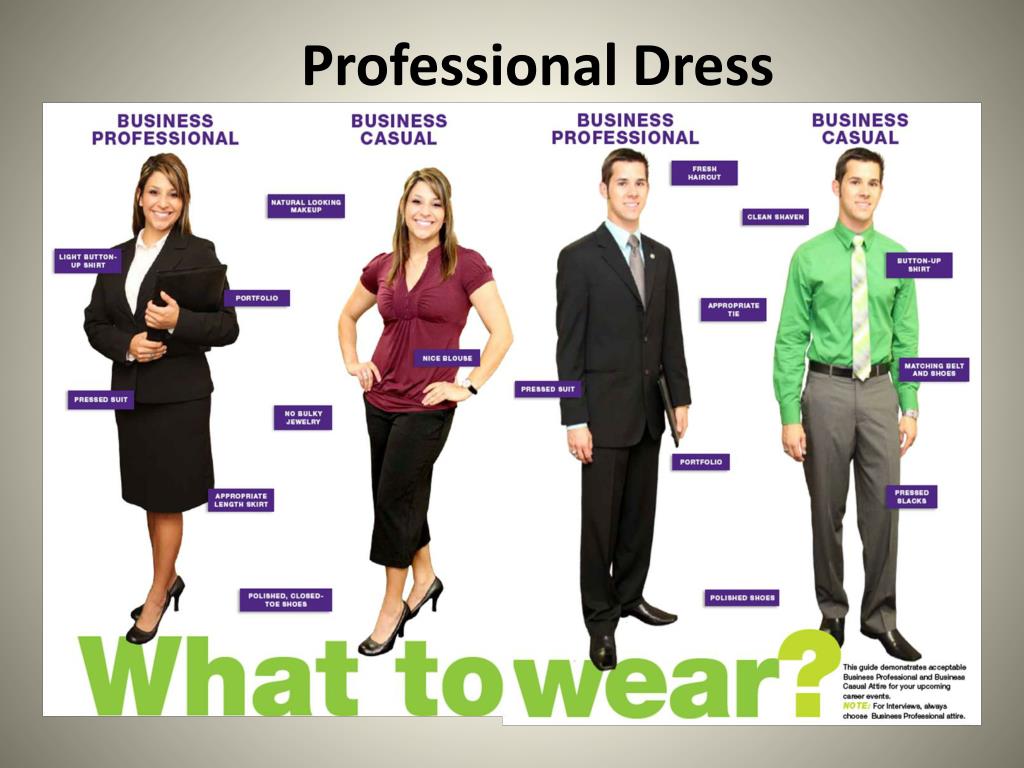
Credit: www.slideserve.com
Overcoming Personal Dress Code Insecurities
Dress code in presentation: overcoming personal dress code insecurities.
When it comes to giving a presentation, one of the key factors that can impact your confidence and performance is the dress code. Dressing appropriately for a presentation not only creates a professional image, but it also helps you feel more confident and capable. However, many people often struggle with personal dress code insecurities. In this blog post, we will explore how to overcome these insecurities and choose the right attire for your presentations.
Boosting confidence through appropriate attire choices
Your choice of attire can have a significant impact on your confidence levels when presenting. When you feel comfortable and confident in what you’re wearing, it shows in your body language and overall presentation delivery. Here are a few tips to boost your confidence through appropriate attire choices:
- Choose clothes that fit you well: Ill-fitting clothes can be distracting and make you feel self-conscious. Ensure your clothes are tailored to your body shape, allowing you to move freely without any discomfort.
- Wear colors that make you feel good: Different colors can evoke different emotions and moods. Choose colors that make you feel confident and positive. For example, wearing bold colors like red or blue can create a sense of authority and command attention.
- Accessorize strategically: Accessories can add a personal touch to your outfit. Choose accessories that align with the formality of the presentation and make you feel empowered. For example, wearing a statement necklace or a stylish watch can enhance your confidence.
Overcoming self-doubt and imposter syndrome
Many people struggle with self-doubt and imposter syndrome when it comes to dressing for a presentation. They may feel like they don’t belong or that their clothes aren’t good enough. Here are a few strategies to overcome self-doubt and imposter syndrome:
- Focusing on your strengths: Remind yourself of your skills, knowledge, and expertise that you’re bringing to the presentation. Dressing well is just one aspect of your overall performance.
- Seeking feedback: If you’re unsure about your attire choices, don’t hesitate to ask for feedback from trusted colleagues or mentors. They can provide valuable insights and help alleviate your self-doubt.
- Practicing self-affirmation: Repeat positive affirmations to yourself before and during the presentation. Remind yourself that you are qualified, capable, and deserving of being in that position.
Navigating personal fashion preferences and workplace expectations
Another challenge when it comes to dress codes is finding a balance between personal fashion preferences and workplace expectations. It’s important to feel authentic and comfortable in what you wear, while also considering the professional expectations of your workplace. Here are some tips for navigating this balance:
- Research the company culture: Understand the dress code expectations of your specific workplace. Take cues from your colleagues and superiors to gauge what is considered appropriate.
- Incorporate personal style: Find ways to incorporate your personal fashion preferences within the boundaries of the dress code. You can express your style through accessories or subtle details while still looking professional.
- Experiment and adapt: Don’t be afraid to experiment with different styles and outfits to find what works best for you. Keep in mind that dressing appropriately for each presentation is essential, as it shows respect for your audience and the occasion.
In conclusion, overcoming personal dress code insecurities requires considering appropriate attire choices, tackling self-doubt and imposter syndrome, and navigating the balance between personal fashion preferences and workplace expectations. By following these strategies, you can dress confidently for your presentations and create a positive impression on your audience.
Additional Resources:
- Forbes – How to Dress for Success: Forbes Five Expert Panel
- The Muse – How to Dress Professionally in Office Clothes

Addressing Dress Code Diversity And Inclusion
When it comes to delivering a presentation, your choice of attire can significantly impact how you are perceived by your audience. A well-thought-out dress code not only contributes to your professionalism but also plays a crucial role in fostering inclusivity and diversity in the workplace. In this section, we will explore how you can promote inclusive dress code policies, avoid gender bias in dress code expectations, and accommodate diverse cultural and religious attire.
Promoting Inclusive Dress Code Policies
In order to create an inclusive work environment, it is essential to establish dress code policies that consider the diverse backgrounds and preferences of your employees or audience. Here are some strategies to promote inclusivity:
- Promote individuality: Encourage employees to express their personal style while adhering to professional standards. Emphasize that diversity in appearance is celebrated and respected.
- Flexibility in attire: Provide flexibility in dress code options to accommodate various preferences. This could include allowing casual attire on specific days or providing guidelines that allow for a range of formal and semi-formal attire.
- Open communication: Regularly seek feedback from employees and stakeholders to ensure that dress code policies are inclusive and considerate. Open dialogue can help identify and address any potential issues or concerns.
Avoiding Gender Bias in Dress Code Expectations
Traditional dress codes often impose gender-specific expectations that can perpetuate bias and inequality. It is crucial to avoid such biases and create a more inclusive environment. Here are a few steps you can take:
- Neutral guidelines: Implement dress code policies that apply equally to all genders. Focus on guidelines that emphasize professionalism, cleanliness, and appropriateness rather than specific gender expectations.
- Eliminate gender-specific clothing requirements: Remove any requirements that impose specific clothing expectations based on gender. For example, avoid mandating skirts or dresses for women or suits for men, unless job-specific considerations require it.
- Education and awareness: Provide training and resources to raise awareness about gender biases in dress codes and its impact on inclusivity. By educating employees and management, you can promote a more understanding and inclusive environment.
Accommodating Diverse Cultural and Religious Attire
In a diverse workplace or audience, accommodating diverse cultural and religious attire is of utmost importance to promote inclusivity and respect. Here’s how you can ensure that your dress code policies accommodate diverse attire:
- Education and awareness: Foster understanding of cultural and religious attire by educating employees and management about different practices. Encourage sensitivity and respect towards diverse clothing choices.
- Flexible guidelines: Establish guidelines that allow employees to adhere to their cultural or religious attire within reasonable boundaries. Consider providing options for customizing attire guidelines to accommodate various needs.
- Consultation and accommodation: Create a process where employees can request reasonable accommodations for cultural or religious attire. Engage in open and respectful communication to find solutions that meet both the individual’s needs and the organization’s requirements.
By addressing dress code diversity and inclusion, you create an environment that values diversity and ensures everyone feels comfortable and respected. Implementing inclusive dress code policies, avoiding gender bias, and accommodating diverse cultural and religious attire contribute to a workplace that fosters inclusivity, productivity, and success.
Frequently Asked Questions On Dress Code In Presentation
Why is dress code important in presentation.
Dress code is important in presentations because it creates a professional and polished image.
Should You Dress Up For A Presentation?
Yes, dressing up for a presentation is important as it creates a professional impression.
Can I Wear Jeans For Presentation?
Yes, you can wear jeans for a presentation, as long as they are appropriate for the setting and convey a professional image.
What Is The Appropriate Dress Code For A Presentation?
The appropriate dress code for a presentation depends on the context and audience. Generally, it is best to dress professionally, wearing business attire or smart casual attire. Dressing appropriately will help you make a positive impression and maintain the attention and respect of your audience.
Maintaining an appropriate dress code in presentations is crucial for creating a positive impression and showcasing professionalism. The way we dress not only reflects our personal style but also influences how others perceive us. By dressing in a manner that is in line with the company culture and the audience’s expectations, we can establish credibility and trust.
It is important to choose attire that is comfortable, fits well, and allows us to move freely. The use of muted colors and minimal accessories can help keep the focus on the content being presented. Remember to always consider the occasion and dress accordingly, whether it is a formal business meeting or a more casual event.
By following these dress code guidelines, we can present ourselves in the best light and enhance our chances of success in professional settings.
Similar Posts
How to end a presentation.
Are you tired of ending your presentations with a whimper instead of a bang? Do you want to leave a lasting impression on your audience and make them remember your key message? Look no further! In this article, we will dive into the art of ending a presentation with impact. From powerful closing statements to…
How To Prepare For A Conference?
Are you attending a conference soon? Wondering how to make the most out of your experience? Look no further! In this guide, we will provide you with valuable tips and tricks on how to effectively prepare for a conference. From setting clear objectives to networking strategies, we’ve got you covered. So, let’s dive in and…

How to Become a Presentation Designer?
To become a presentation designer, you need to possess knowledge of programs like PowerPoint, Google Slides, Prezi, Keynote, and Adobe Creative Suite software such as Photoshop, InDesign, and Illustrator. Additionally, having experience in working under pressure and managing multiple tasks and projects simultaneously is essential. As a presentation designer, these skills will enable you to…
Types of Presentation You Need to Know
Presentations come in various forms, each tailored to suit different purposes, audiences, and content. Here are some common types of presentations: Each type of presentation requires a tailored approach in terms of content, structure, and delivery to effectively achieve its goals and engage the intended audience. More Details of the Types of Presentations The above…
How To Begin A Presentation?
Are you tired of starting your presentations with a dull and predictable opening? Do you want to captivate your audience from the very beginning and leave a lasting impression? Look no further! In this article, we will explore the art of beginning a presentation in English, and discover effective techniques to ensure your audience is…

What are Presentation Strategies?
Presentation strategies refer to the thought-out plans and ideas used to deliver a message effectively to a specific audience. These strategies aim to capture the attention and engage the listeners or viewers, ensuring that the presentation is impactful and memorable. Whether it’s a short five-minute talk or a lengthy presentation, having a clear strategy in…
9 Things to Wear (and 3 to Avoid) for a Presentation
While the occasion may not come around too often, more likely than not, you’ll have to present your own ideas at work at some point. And before you’re standing in front of your bosses and colleagues sharing that business proposal or pitch, figuring out what to wear for a presentation should be the least of your worries.
Once you’ve practiced your speech a few times and prepped the room, all that’s left is to dress the part. To take away the added stress of finding the right outfit for your big moment, we tapped Lauren McGoodwin, founder and CEO of Career Contessa , for her best advice on what to wear based on your work environment.
“When dressing for a presentation, it’s important to wear something you’re comfortable in, and something that makes you feel confident,” says McGoodwin. In a formal setting, she recommends a full suit . “I’d recommend going with a fitted black or navy suit, comfortable heel, and classic hair.”
If your office has a more creative flair, don’t be afraid to let that show through your look. “There’s room to experiment, but you still want to keep it professional with fitted pieces, such as a colorful pencil skirt or a long-sleeve dress,” McGoodwin tells us.
Working at a startup? A casual environment still calls for a level of professionalism during certain moments, and a presentation is no exception. “Denim is pretty widely accepted in the startup environment, but keeping the professional tone, I’d recommend a dark wash and adding a great blazer .”
McGoodwin also suggests leaving anything that restricts your ability to move at home—after all, this type of meeting requires gestures and movement in the room. She says to leave those ripped jeans, loose-fitting tops, and teetering heels at home for another time. Now, shop our favorite looks to ace your next presentation.

When working in a more formal environment, it's important to dress the part—especially when it comes to giving a presentation. Show your colleagues that you mean business with suit pieces like a blazer and tailored trousers.
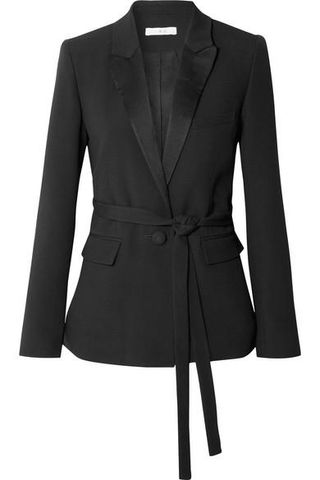
Nothing says promotion like a chic power blazer. Available in sizes FR 34 to FR 42.
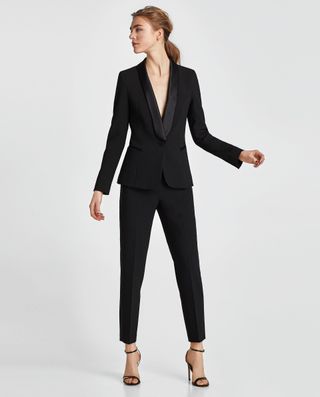
Dress to impress in this blazer and the matching bottoms ($50) and ace your next presentation. Available in sizes XS to XL.
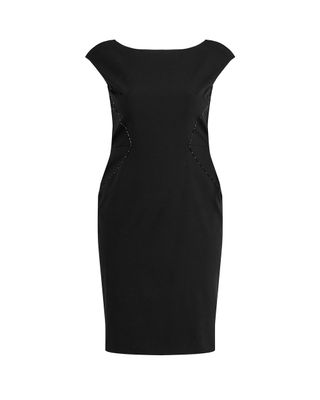
In this dress, you mean business. Available in sizes 10 to 20.

If you happen to work in a more creative environment that allows a bit more sartorial freedom, let your personality shine while staying polished for your presentation. A textured skirt or pants will pair so well with an easy and chic button-down.
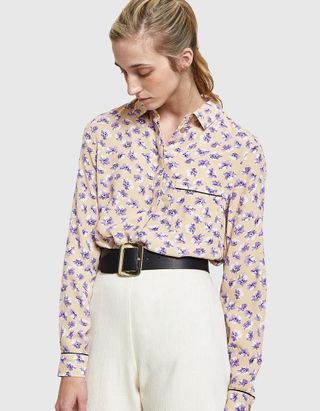
You'll want to wear this print all season long. Available in sizes 34 to 40.
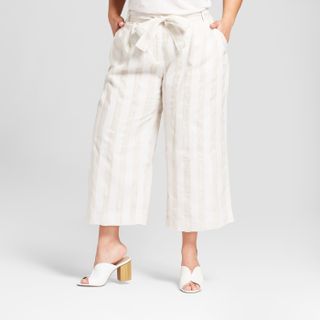
These are so perfect for spring and summer. Available in sizes 2 to 26W .
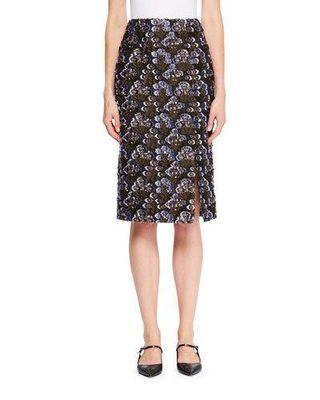
This skirt will show just the right amount of your personality. Available in sizes 2 to 10.

Just because you work at a casual startup company doesn't mean that you have to dress the part. Stay stylish and professional with a streamlined ensemble of skinny jeans and a top with an unexpected detail.
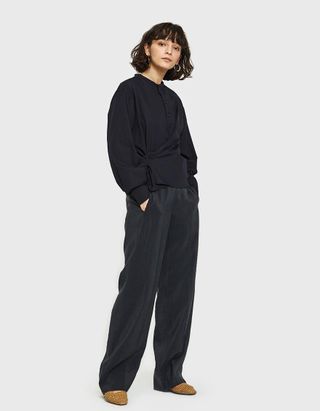
This twist detail is so unique. Available in sizes 34 to 40.
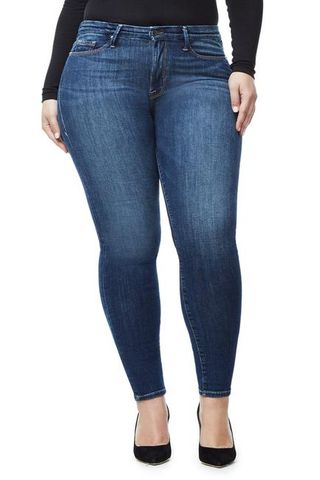
If you're in a casual startup environment, wear these for work or for the weekend. Available in sizes 00 to 24.
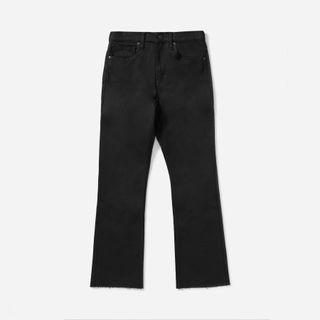
These jeans are so flattering. Available in sizes 24 to 33.
With these pieces, you’ll be sure to command the room the next time you’ve got a presentation in the books.

Sponsor Content Created With Free People
By Humaa Hussain
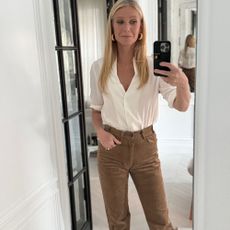
I can see why they love it.
By Natalie Munro
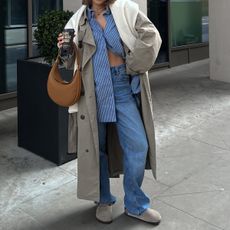
They're selling out like crazy.
By Sierra Mayhew

Save for a sunny day.
By Caitlin Burnett

From designer styles to high-street hits.
By Yusra Siddiqui

I'm taking notes.

Untangling a complicated dress code.
By Avalon Afriyie
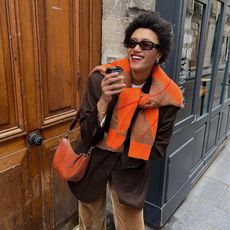
Exclusively for you.
By Bébhinn Campbell
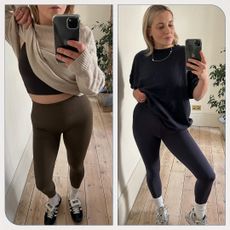
Every brand, tried and tested
By Rebecca Rhys-Evans
A fashion editor's favourites.
By Remy Farrell
- Contact Future's experts
- Terms and conditions
- Privacy policy
- Cookies policy
- Accessibility Statement
- Advertise with us
Who What Wear UK is part of Future plc, an international media group and leading digital publisher. Visit our corporate site . © Future Publishing Limited Quay House, The Ambury, Bath BA1 1UA. All rights reserved. England and Wales company registration number 2008885.
What to Wear for a Presentation: 10 Tips
by Rob Biesenbach | Presentation/Speech Tips

Like it or not, audiences are making all kinds of conscious and unconscious judgments about you before you even utter your first word. They’re looking for clues about whether you’re worth their attention, and most of those clues come from your appearance — your posture, your gait, your hair and, yes, your wardrobe.
So it’s really important that you set the right tone from the start, and wear clothes that make a strong first impression or, at minimum, don’t undermine you.
Here are my tips on common wardrobe pitfalls and how to avoid them..
1. Dress to Feel Good

Most of us have a go-to outfit or article of clothing like this in our closet. Choose that and you’re much more likely to feel poised and confident in front of an audience.
2. Dress to Look Good
Of course, there are reasonable limits to Rule 1. If your “feel good” clothes are the ones you wear to mow the lawn or go to the gym, that’s obviously not going to work for a big presentation.
The traditional rule of thumb is that you should dress one level above your audience. In the business casual era, that’s getting harder to figure out, but the general principle is, if your audience is wearing sport coats, you wear a suit, if they’re in khakis and button downs you put on a sport coat, etc.
And I apologize. I know these examples are completely male-centric, but that’s what I happen to be. If you’re looking for advice specific to women, there are people (women) to consult who are more qualified than I am to weigh in on this.
The bottom line is, your wardrobe should help you project authority. You should look like you belong up there sharing knowledge with a group. So whatever level of dress you wear, from a t-shirt to suit, it should be high quality, well tailored and contemporary.
3. Dress for the Audience/Venue
Figuring out what to wear for a presentation used to be so easy. Throw on a business suit and tie (or a sharp dress or suit for women) and you were all set. But outside of a few industries, hardly anyone wears neckties these days. (And even for those professions that do, like the law, they usually dress down for conferences and similar events.)
So you want to look to your audience for context. The tech industry is a widely cited example — show up at a conference of developers in a suit and tie and you’ll be written off as old-fashioned and out of touch.
But you never know. I have one client whose people all wore suits and ties to my workshops; on the other hand, I spoke to a bunch of lawyers who were dressed in jeans.
The smart thing to do is to check with the organizers in advance and to dress with flexibility in mind so you can change things up on-site (add a tie or shed a jacket, for instance).
4. Dress for Your Brand (Who You Are)
Your clothes should match who you are. A zany creative type will probably dress in an edgy or avante garde way. A risk management consultant would look more at home in a conservative suit.
It all depends on where you “belong” — in the boardroom or the backroom.
Also, a suit and tie doesn’t have to be stodgy. A trendy outfit — slim pants, fitted jacket, narrow tie, spread collar — makes a statement of its own.
5. Avoid Brand New Clothes
Always road test your outfits before wearing them on stage. Standing in the spotlight in front of several hundred people is a terrible time to find out that your shirt has an annoying tag that chafes your neck or your pants get easily wrinkled or your fabric is more sheer than you expected.
6. Don’t Try to Be Hip if You’re Not
The latest uniform among middle-aged men seems to be jeans, sport coats and t-shirts. If you’re going to try to pull this off, here are a few guidelines:
- Invest in high quality, fashionable jeans tailored to your physique. The cool factor you’re going for will be totally undermined by “dad (or mom) jeans,” baggy, slouchy jeans, or the kind of jeans you’d wear to mow the lawn.
- Make sure you wear a blazer or sport coat that pairs well with jeans. I see a lot of guys throw on what is very obviously a suit jacket over jeans and that is wrong, wrong, wrong. Read up on the important difference between suits, sport coats and blazers.
- If you must wear a t-shirt (as opposed to, say, a button down), make sure it’s a nice one that fits well and isn’t all stretched out or faded. And if the label says “Hanes” or “Jockey” what you have is an under shirt.
7. Keep it Simple
If the audience’s main takeaway is remembering what you wore, you’re doing it wrong. Unless you have a certain brand that calls for bright red pants or a hat with a giant yellow feather, it’s best to dress simply. Avoid colors or accessories or jewelry that might distract the audience, make noise or cause a glare under stage lights.
8. Wear Something that Holds a Lavalier
The best placement for a lavalier (clip-on) microphone is centered on your upper chest. People often clip them to a lapel, but that’s a bad idea because every time you turn your head, the sound level will change.
The ideal thing to wear to accommodate a lavalier is a button down shirt (it should go near the second button) or a necktie (clip it a few inches below the knot).
For everything else, it all depends on the type of clips the AV people have and whether there are actual AV pros there at all. Do your research or consult an AV professional (which I am NOT) if you can.
9. Double-check the Program
This is a funny one. A friend recently reported feeling chagrined to discover that the outfit she was wearing for a speech was the same appearing in her conference program photo.
I personally have given up worrying about this, as I happened to wear a favorite outfit in my headshots and I don’t have enough clothes to just stop wearing it for speeches!
But if this is an issue for you, keep it in mind. Also, it’s one more good reason to dress in something basic and neutral — either for your headshot, on stage or both.
10. Take Off That Name Tag!
Most of all, focus on what matters.
Off the top of my head I can list more than a dozen things more important to a presentation’s success than your choice of clothing: the power of your ideas, how clearly they’re structured, the energy and passion you bring to them, your connection to the audience, the way you move and gesture, and more.
Compared to all that, figuring out what to wear for a presentation seems downright trivial. But an inappropriate outfit can handicap you from the start. And the right one can make a subtle but important difference in the way you feel and the authority you project.
When it comes to presentations, the little things often add up to something big, so a few extra moments’ consideration — and some extra investment — should be well worth it.
Photo Credit: Orbmiser Flickr via Compfight cc
Let's Work Together
To find the right solution for you, Rob’s happy to talk through the options.
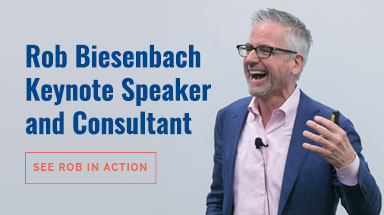
Recent Posts
How to use video to improve your presentation skills, presentation anxiety don’t forget to breathe.
- The Gladwell Method: The Route to Powerful Storytelling
6 Tips for Handling Negative Feedback
- How to Connect: A Tale of Two Sidneys
- Communication Skills
- Presentation/Speech Tips
- Storytelling
- Writing/Editing
Related Articles
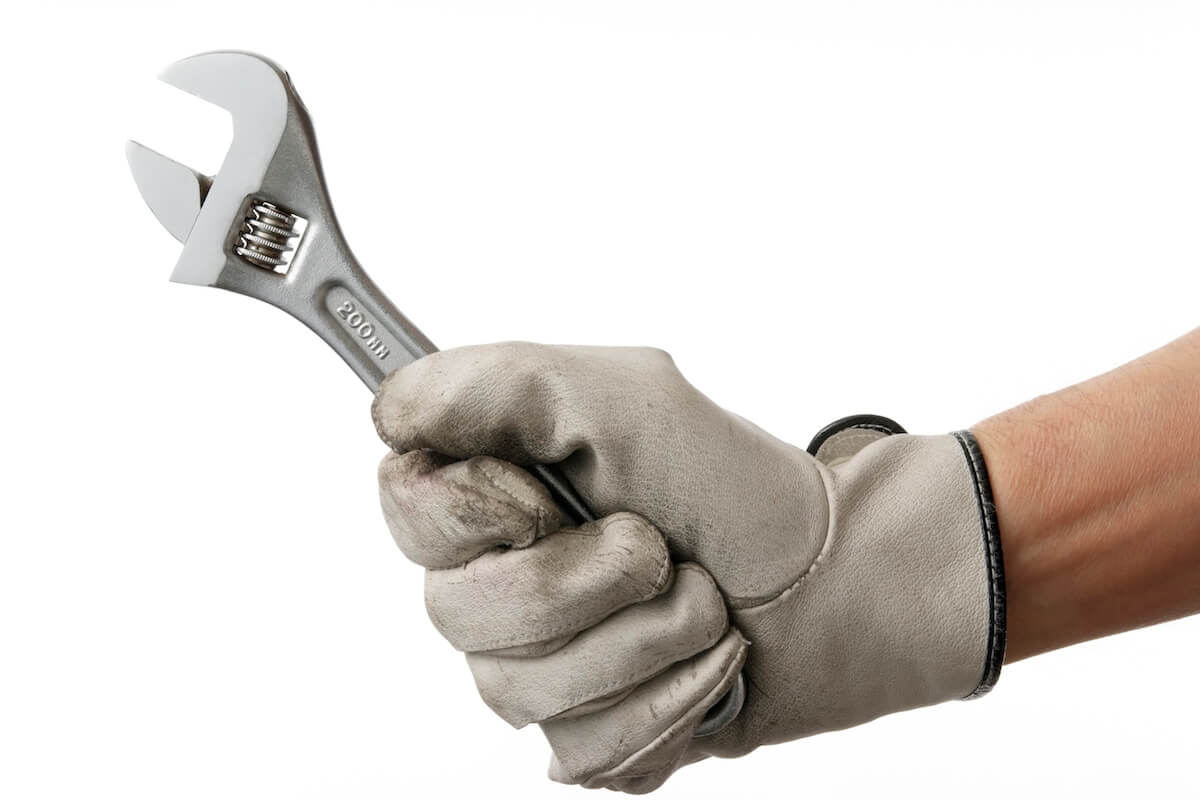
Master Your Presentations
Join our mailing list to receive 5 Checklists to manage every detail of your next presentation.
You have Successfully Subscribed!
By signing up, you agree to join Rob's newsletter and receive emails. We respect your privacy and abide by strict privacy policies.

IMAGES
VIDEO
COMMENTS
Before you hit the stage, raid your closet with the help of our presentation outfit style guide to select the best attire for your next presentation.
Different industries have different dress codes. Know your audience and dress accordingly. Whether it's a suit for a corporate gig or business casual for a startup, your outfit …
What should you wear on stage speaking? What colours and styles of clothing are best? When all eyes are on you, it's not just your content that matters. Find out how to nail your visual presentation with the right outfit.
How to dress for a presentation is ultimately about respect for the audience, the context, yourself and your message. Add to these an understanding of your body and what …
The appropriate dress code for a presentation depends on the context and audience. Generally, it is best to dress professionally, wearing business attire or smart casual attire. Dressing appropriately will help you …
“When dressing for a presentation, it’s important to wear something you’re comfortable in, and something that makes you feel confident,” says McGoodwin. In a formal setting, she recommends a full suit. “I’d …
Its important to match your level of formality to suit your workplace and your audience eg a relaxed presentation to your colleagues vs a formal pitch to a new corporate …
So it’s really important that you set the right tone from the start, and wear clothes that make a strong first impression or, at minimum, don’t undermine you. Here are my tips on common wardrobe pitfalls and how to …